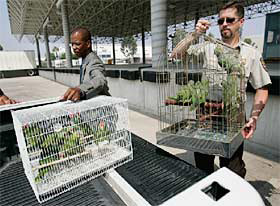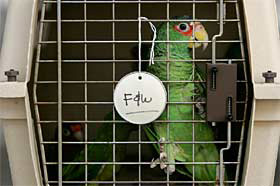 |
 |
 |
 Editorials | Environmental | August 2007 Editorials | Environmental | August 2007  
Endangered Birds Returned to Mexico
 Allison Hoffman - Associated Press Allison Hoffman - Associated Press
go to original


| | Special agent John Brooks (left) and wildlife inspector Michael Muehlbauer of the U.S. Fish and Wildlife Service loaded cages of Amazon parrots into trucks. (Peggy Peattie/Union-Tribune) | 
| | Amazon parrots, protected by U.S. and international law, were confiscated from smugglers this year and returned to Mexico. (Peggy Peattie/Union-Tribune |
Otay Mesa – From inside their cages, the confiscated parrots squawked and whistled as they were placed inside a truck belonging to Mexico's environmental protection agency this week.

The 149 Amazon parrots, more than half of them found by border inspectors in San Ysidro and Otay Mesa over the past three months, were going home.

“Bonita,” shouted one. The word means “pretty” in Spanish.

“Hello,” croaked another.

They had been plucked from their habitats in Mexican states such as Michoacan, Veracruz and Tamaulipas, and stuffed inside boxes and bags to be smuggled into the United States.

In some cases, it was their chattering that gave them away.

This week at the Otay Mesa border crossing, they were handed over to Mexican officials who promised the parrots would be returned to the wild, or in the case of those that had become too domesticated, used for breeding to replenish the species.

“It's a great day to take back these birds,” said Ricardo Castellanos, the Baja California director of the Mexican environmental agency known by its acronym PROFEPA. “Some of them are in danger of extinction.”

The birds included five species of the Amazon parrot, he said, ranging in age from 1 to 5 years.

A total of 1,000 exotic birds, mostly parrots, have been found along this section of the border since 1999, resulting in a total of five parrot “repatriations.”

John Brooks, special agent with the U.S. Fish and Wildlife Service, said those numbers represent a small percentage of the birds that make it through. The parrots are popular for their bright plumage and the ability of some of them to mimic words and sounds, but U.S. authorities said it's illegal to transport Amazon parrots into the United States for commercial purposes.

Since 1999, bird smuggling investigations have yielded 31 arrests, Brooks said.

Lisa Nichols, also a wildlife service special agent, said a major parrot ring was busted in 2004 and for a while, officials saw a dip in the availability of parrots at the swap meets and pet stores they monitor. However, more smuggled parrots have started showing up recently at the border.

“All of a sudden, there's now an upsurge,” she said.

An investigation is continuing into this latest wave of smuggled parrots – 82 since May – which has already resulted in two arrests, said Lorraine Concha, assistant special agent in charge of the San Diego office of U.S. Immigration and Customs Enforcement.

Castellanos, of PROFEPA, said Mexican authorities have also recently arrested three people involved in trafficking birds.

U.S. authorities said the animal smuggling trade does damage on both sides of the border: It robs countries like Mexico of native species, and also creates a health risk north of the border with the possible introduction of diseases that can hurt the poultry industry and cause sickness in humans.

That's why U.S. authorities want people to think twice and about buying unusually inexpensive birds. Nichols said yellow-head Amazon parrots typically cost from $800 to $1,000 if they come from legal domestic breeding facilities.

On the black market, the birds sell for $300 to $500. People who buy these birds are encouraging the illegal trade, she said.

“It's no different from going out in a back alley and buying a watch that's one-third the cost, and you know it's stolen property and you buy it anyway,” she said.

Anna Cearley: (619) 542-4595; anna.cearley@uniontrib.com | 
 | |
 |



